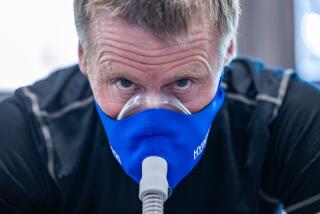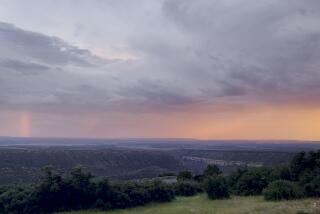CONSUMER TRAVEL : Hunting for the Right Expedition Can Be a Real Adventure : Trends: Whether the destination is Africa or Arizona, one’s choice of outfitter can make the difference between a good trip and a disappointing, or disastrous, one.
- Share via
A few years ago I took a three-week safari through the game parks of Kenya and Tanzania with an adventure company that billed itself as “educational.” The literature touted guides knowledgeable in the culture of the people, the ecology of the land, and the idiosyncrasies of the animals.
None of this was true. In fact, our group of 20 soon discovered that we had no real guides at all. The company saved money by not employing an expert leader. Instead, our safari vehicle drivers, who knew little beyond the correct routes to follow each day and how to track animals, were expected to instruct us as best they could.
Starving for information at the various game reserves, we ended up begging guides from other tour groups to let us listen in on their talks. The next time I went to Africa--to see the gorillas of Zaire and Rwanda--I signed up with one of the companies that had let me listen in on the Kenya/Tanzania trip. The gorilla journey was a feast of information after the crumbs of the previous trip.
Whether you’re tracking game in Africa, rafting wild rivers in Chile, or biking and hiking the California coast, the outfitter you choose could mean the difference between the vacation of your dreams and a bitter--and often costly--disappointment. And with trips that involve a level of physical danger, your choice could mean life or death.
According to a 1991 Harvard Business School study, there are more than 5,000 North America-based outfitters offering some kind of adventure travel. Trips run the gamut from soft adventures, where participants travel in comfort with few physical demands, to rugged adventures involving challenging physical activity and camping, to exploratory excursions where group members are guinea pigs of sorts, helping the outfitter “rough out” new itineraries and terrains of undetermined difficulty.
Be very clear what you’re up for--physically and spiritually--before you begin to peruse the glossy promotional brochures that make every trip seem wonderful. Do you want a true adventure, subject to the whims of nature and other uncontrollable circumstances, or are you seeking an “adventure experience” with most of the comforts of home? How important are the quality of food and accommodations? How vital are precise time schedules and readily available showers?
Many companies have a consistent approach and target audience that identifies their style of travel: For example, Abercrombie & Kent caters its cushy African safaris mainly to an older crowd seeking substantial comforts and willing to pay for them; Butterfield & Robinson takes the same approach with its hiking, biking and walking tours through Europe and Canada. A younger or more athletic vacationer might prefer the more challenging treks and river trips run by Wilderness Travel, Overseas Adventure Travel, Mountain Travel/Sobek and Inner Asia. Some companies offer two versions (soft and rustic) of the same trips. Backroads offers both camping and inn-stay options on its bike trips through the California wine country and Pacific Northwest; Baja Expeditions gives customers a choice of kayaking-and-camping or yacht-based travel on its whale watching trips to Mexico’s Magdalena Bay and Sea of Cortez.
Once you’ve determined your taste in trips, take a long, hard look at the companies marketing the excursions. They are not all created equal.
One of the most important facts to ascertain is whether the firm runs its own trips or simply acts as a middleman, booking an outfitter and taking a cut off the top, with negligible oversight or control.
A few years back, I arrived in Papua New Guinea for what was supposed to be a hiking excursion among the colorful Huli wigmen of the Southern Highlands, only to be told that the local outfitter (subcontracted by the large American company with which I had booked) had decided instead to have us climb a remote, uninhabited mountain. I don’t do mountains and neither did the hefty elderly couple from Florida who joined me in protest. After much arguing, the outfitter agreed to split our group in half, taking some people up the mountain and others to see the Hulis.
Because of all the itinerary shifts, the outfitter could not arrange several excursions promised in the brochure--a visit to a major wildlife sanctuary and a river-rafting day trip among them.
These disappointments were minor, however, compared to our biggest surprise of the trip. On the last leg of the journey, while gliding down the Sepik River in a motorized 40-foot canoe on a handicraft-buying excursion, we were ambushed by a boatload of bandits brandishing guns and machetes. In a move reminiscent of Indiana Jones, our guides jumped the attackers, knocking them and their weapons into the water. After an alarming amount of punching and yelling, our guys managed to swim quickly back to our boat and we escaped at top speed with lives and purchases intact.
We later learned that the part of the Sepik we had been navigating was becoming notorious for such attacks, but our outfitter had chosen to ignore the danger and take us, unarmed, into the region anyway. Had the booking company back in the U.S. maintained closer contact with the outfitter and conditions in Papua New Guinea, we might have been spared both the discord of the first leg of the trip and the dangers of the last segment.
No amount of checking can guarantee you won’t encounter an occasional disappointing leader or perilous predicament (this is after all, adventure travel, often involving some potential for the unexpected), but careful investigation can go a long way toward assuring a satisfying trip.
Following are key questions to ask prospective tour companies. If you can, talk to the trip leader as well to get a sense of his or her attitude and experience. Also, get the phone numbers of previous customers for some firsthand evaluations of specific itineraries and satisfaction with the company in general.
1. How long has the company been in business? While new companies may offer quality trips, it stands to reason that the longer a company has been in business, the more familiar it is with the terrain it travels and the more experience its guides have getting out of jams.
2. How does the company research its trips? A good company will conduct scouting trips before launching a new itinerary. Key personnel (preferably the owner/director and certainly potential trip leaders) should check out every facet of an excursion, including local guides, hotels, restaurants, campgrounds and transportation sources.
3. Does every trip include a leader with expertise on the route? The best trips include at least one knowledgeable representative of the company, instead of relying solely on local drivers, trackers or other technical staff. The leader acts both as an educational source and as a liaison between group members and support staff.
4. How does the company determine its group size for each trip? I’ve been on trips with 40 participants and trips with six, and without exception, smaller is better. You’ll pay more for that privilege (sometimes companies list a range of prices, depending on how many people they get to sign up for a trip), but you’ll get a more intimate, higher quality experience.
5. How are trips graded for difficulty? Some companies have very specific criteria for scoring trips, from grade 1 (easy travel, usually by motor vehicle) to grade 5 (technical skills required for mountain climbing and wilderness trekking), while others use a loose system of easy, moderate, strenuous. One person’s easy may be another’s strenuous, however, so be sure to ask about the elements of the trip that make it qualify for one category or another. And while you’re at it, discuss any physical ailments you have (asthma, allergies, obesity) that might make a trip risky. A good company will include an extensive medical questionnaire for strenuous trips, sometimes requiring a doctor’s testament to your physical condition.
6. What sort of medical training do leaders and support staff have? This can mean the difference between life and death on a risky adventure such as a mountain climb, and it’s always good to know there is someone along with basic first-aid skills. Many companies offer free or discounted trips to customers who are doctors or nurses.
More to Read
Sign up for The Wild
We’ll help you find the best places to hike, bike and run, as well as the perfect silent spots for meditation and yoga.
You may occasionally receive promotional content from the Los Angeles Times.






